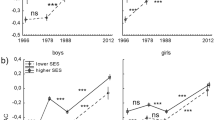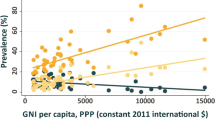Abstract
Background/Objectives
Recent evidence suggests nonconstant nature of dispersion in adult women’s body mass index (BMI) across sociodemographic groups. The overall variances in BMI and height are also shown to have substantially changed over time. We modeled complex variation in adults’ anthropometry—BMI and height—by wealth and education, and assessed their differences over time in India.
Subjects/Methods
Data from a total of 768,130 women and 180,691 men from the Indian National Family Health Survey (NFHS) 2006 and 2016 were used for the analysis. The average association between wealth and education with anthropometry was assessed from linear regression models assuming constant variance. Individual heterogeneity was modeled to obtain separate variances in anthropometry for each wealth quintile and education level. All analyses were stratified by survey year and sex.
Results
On average, the positive socioeconomic gradient in adult’s BMI and height persisted over time with slight attenuation. The residual variance in BMI ranged from 10.1 to 14.9 (7.2–11.3) by education level and 6.1 to 17.4 (5.0–13.0) by household wealth for women (men) in 2006, and they increased over time for the lower socioeconomic groups but remained the same or decreased for the higher socioeconomic groups. No significant pattern was observed for variation in height for both genders.
Conclusions
We found potential reversal in the socioeconomic patterning in BMI variability in India as suggested by the increasing dispersion among the least educated and poorest populations. For a comprehensive understanding of nutrition transition in developing countries, it is necessary to assess the changes in means and variances of anthropometry in tandem.
This is a preview of subscription content, access via your institution
Access options
Subscribe to this journal
Receive 12 print issues and online access
$259.00 per year
only $21.58 per issue
Buy this article
- Purchase on Springer Link
- Instant access to full article PDF
Prices may be subject to local taxes which are calculated during checkout


Similar content being viewed by others
References
Perkins JM, Subramanian S, Davey Smith G, Özaltin E. Adult height, nutrition, and population health. Nutr Rev. 2016;74:149–165.
Popkin B, Slining M. New dynamics in global obesity facing low‐and middle‐income countries. Obes Rev. 2013;14:11–20.
Bozzoli C, Deaton A, Quintana-Domeque C. Adult height and childhood disease. Demography. 2009;46:647–69.
Deaton A. Height, health, and development. Proc Natl Acad Sci. 2007;104:13232–7.
Subramanian S, Perkins JM, Özaltin E, Davey Smith G. Weight of nations: a socioeconomic analysis of women in low-to middle-income countries. Am J Clin Nutr. 2010;93:413–21.
Subramanian S, Smith GD. Patterns, distribution, and determinants of under-and overnutrition: a population-based study of women in India. Am J Clin Nutr. 2006;84:633–40.
McLaren L, Gauvin L. Does the ‘average size’of women in the neighbourhood influence a woman’s likelihood of body dissatisfaction? Health Place. 2003;9:327–35.
Sobal J, Stunkard AJ. Socioeconomic status and obesity: a review of the literature. Psychological Bull. 1989;105:260.
Griffiths P, Bentley M. Women of higher socio-economic status are more likely to be overweight in Karnataka, India. Eur J Clin Nutr. 2005;59:1217.
Drewnowski A, Popkin BM. The nutrition transition: new trends in the global diet. Nutr Rev. 1997;55:31–43.
Steckel RH. Height and per capita income. Hist Methods. 1983;16:1–7.
Subramanian S, Özaltin E, Finlay JE. Height of nations: a socioeconomic analysis of cohort differences and patterns among women in 54 low-to middle-income countries. PLoS ONE. 2011;6:e18962.
Perkins JM, Khan KT, Smith GD, Subramanian S. Patterns and trends of adult height in India in 2005–2006. Econ Hum Biol. 2011;9:184–93.
Hübler O. The nonlinear link between height and wages in Germany, 1985–2004. Econ Hum Biol. 2009;7:191–9.
Kim R, Kawachi I, Coull BA, Subramanian SV. Patterning of individual heterogeneity in body mass index: evidence from 57 low-and middle-income countries. Eur J Epidemiol. 2018;33:741–50.
Razak F, Corsi DJ, Subramanian S. Change in the body mass index distribution for women: analysis of surveys from 37 low-and middle-income countries. PLoS Med. 2013;10:e1001367.
Krishna A, Razak F, Lebel A, Davey Smith G, Subramanian S. Trends in group inequalities and interindividual inequalities in BMI in the United States, 1993–2012–. Am J Clin Nutr. 2015;101:598–605.
Gausman J, Guevara IM, Subramanian S, Razak F. Distributional change of women’s adult height in low-and middle-income countries over the past half century: an observational study using cross-sectional survey data. PLoS Med. 2018;15:e1002568.
Razak F, Davey Smith G, Subramanian S. The idea of uniform change: is it time to revisit a central tenet of Rose’s “Strategy of Preventive Medicine”. Am J Clin Nutr. 2016;104:1497–507.
Subramanian S, Kim R, Christakis NA. The “average” treatment effect: a construct ripe for retirement. a commentary on Deaton and Cartwright. Soc Sci Med. 2018;210:77–82.
Vaezghasemi M, Razak F, Ng N, Subramanian S. Inter-individual inequality in BMI: an analysis of Indonesian Family Life Surveys (1993–2007). SSM-Popul Health. 2016;2:876–88.
IIPS. NFHS-4 (National Family Health Survey-4). India: International Institute for Population Studies; 2017.
IIPS. India National Family Health Survey (NFHS-3), 2005–06. India: International Institute for Population Sciences; 2007.
Filmer D, Pritchett LH. Estimating wealth effects without expenditure data—or tears: an application to educational enrollments in states of India. Demography. 2001;38:115–32.
Goldstein H. Heteroscedasticity and complex variation. In: Everrit B, Howell D, editors. Encyclopedia of statistics in behavioral science. Hoboken: Wiley; 2005:223–32.
Arcaya MC, Tucker-Seeley RD, Kim R, Schnake-Mahl A, So M, Subramanian S. Research on neighborhood effects on health in the United States: a systematic review of study characteristics. Soc Sci Med. 2016;168:16–29.
Goldstein H, Healy MJ, Rasbash J. Multilevel time series models with applications to repeated measures data. Stat Med. 1994;13:1643–55.
Vrieze SI. Model selection and psychological theory: a discussion of the differences between the Akaike information criterion (AIC) and the Bayesian information criterion (BIC). Psychological Methods. 2012;17:228.
Lewontin R, Levins R. Schmalhausen’s law. Capital Nat Soc. 2000;11:103–8.
Galea S, Ahern J, Karpati A. A model of underlying socioeconomic vulnerability in human populations: evidence from variability in population health and implications for public health. Soc Sci Med. 2005;60:2417–30.
Corsi DJ, Kyu HH, Subramanian S. socioeconomic and Geographic Patterning of Under-and Overnutrition among Women in Bangladesh1, 2. J Nutr. 2011;141:631–8.
Griffiths PL, Bentley ME. The nutrition transition is underway in India. J Nutr. 2001;131:2692–700.
Balarajan Y, Villamor E. Nationally representative surveys show recent increases in the prevalence of overweight and obesity among women of reproductive age in Bangladesh, Nepal, and India. J Nutr. 2009;139:2139–44.
Himmelstein DU, Levins R, Woolhandler S. Beyond our means: patterns of variability of physiological traits. Int J Health Serv. 1990;20:115–24.
Murray CJ, Gakidou EE, Frenk J. Health inequalities and social group differences: what should we measure? Bull World Health Organ. 1999;77:537.
Author information
Authors and Affiliations
Contributions
Author contributions
RK and SVS conceptualized and designed research. RK carried out the analyses and wrote the paper. PKK, NT, and SVS contributed to writing of the initial draft and interpretation of data, and critically reviewed the manuscript for important intellectual content. All authors read and approved the final manuscript.
Corresponding author
Ethics declarations
Conflict of interest
The authors declare that they have no conflict of interest.
Additional information
Publisher’s note Springer Nature remains neutral with regard to jurisdictional claims in published maps and institutional affiliations.
Supplementary information
Rights and permissions
About this article
Cite this article
Kim, R., Kumar Pathak, P., Tripathi, N. et al. Heterogeneity in adult anthropometry by socioeconomic factors: Indian National Family Health Survey 2006 and 2016. Eur J Clin Nutr 74, 953–960 (2020). https://doi.org/10.1038/s41430-019-0511-0
Received:
Revised:
Accepted:
Published:
Issue Date:
DOI: https://doi.org/10.1038/s41430-019-0511-0



